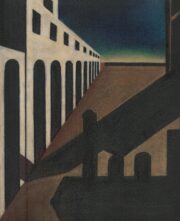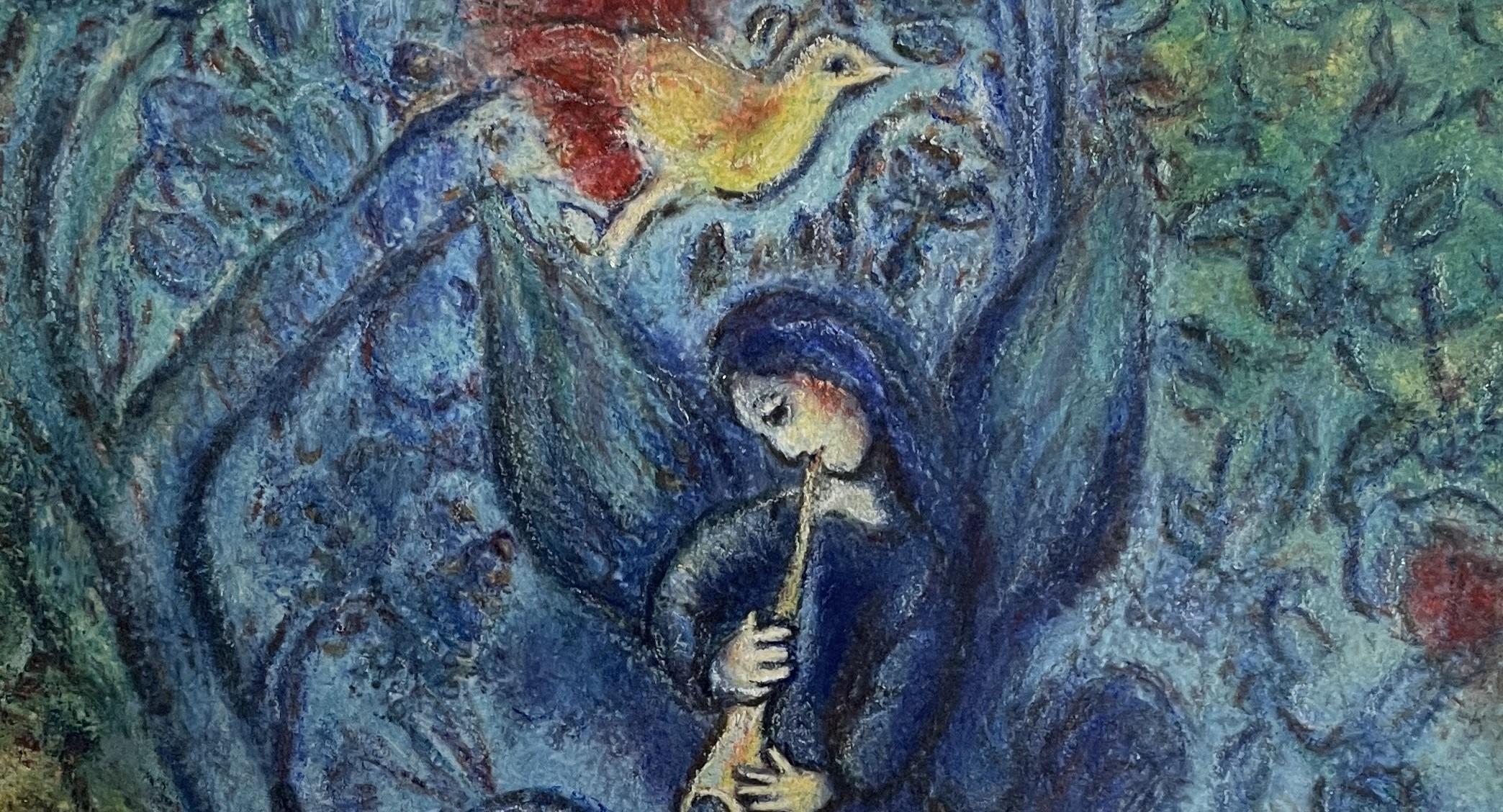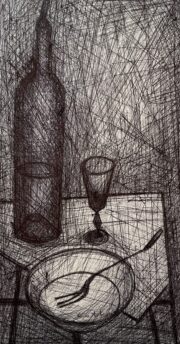日本語-Englishー台灣華語
ジョルジョ・モランディ「静物」
モランディの絵の魅力を人に説明するのは容易ではない。何の変哲もない絵のようでありながら、ひとたび実物を観ると忘れ難い。画集で観るのとは全く違った印象を受ける。その絵は古く見えて新しい。この絵は知り合いの会社の入口にさり気なく飾ってあった。日本の会社もこんなにセンスのいいモランディを飾るようになったのかと嬉しくなる。モランディ縁の人から譲ってもらったとのことだが、モランディの作品の中でもとりわけ素晴らしい作品である。さすがに投資会社だけのことはある。
私がモランディをはじめて観たのは東京都庭園美術館のモランディ展だった。対象を抽象化するのではなく、あるいは写実的に描写するのでもない。禁欲的なまでに簡潔なフォルムを抑制された色彩で描いたモランディの絵には、静謐さの中に確たる存在感があった。展覧会場内にはモランディのアトリエが実物大で再現されていたが、それはとても慎ましく、まるでモランディの絵そのもののようだ。
モランディは朝起きるとただちにこの小さなアトリエで静物画を手がけたという。生まれ故郷のボローニャから出かけることもなく、アトリエに籠もって同じモチーフをひたすら描き続けた。モランディの絵はいくつかの風景画を除き、そのほとんどが机上の器を描いたものである。最初期にはデ・キリコらの形而上絵画に同調したが、ほどなく20世紀現代美術の喧噪から離脱し、孤高の道を歩んで行く。 モランディの絵では、器類は横一列か、あるいは画面の中心に重なり合うように描かれている。この絵でもモチーフの花瓶や箱が身を寄せ合って中央に集められている。日常ではあり得ない配置だ。モランディは明らかに日常と異なる空間を創り出そうとしている。
背景はかなり大きくとられている。全体が同系色に統一されながらも、個々の器は微妙に異なる色と形を持ってそこにある。背景と調和しながら確たる存在を有している。 モランディは色彩をも限定する。モランディの絵は、色が極めて限られ、かつトーンの幅が狭い。全体に抑えたベージュ・クリーム・ブラウンなどの色彩で調子が整えられ、二色にかすかに分けられた背景とテーブルの中に、淡い色調の器が微妙なタッチで描かれている。この絵は全体に白く明るい絵であるが、不思議と見るたびに色が違って見えてしまう。描いているとどのような色であったか、次第に思い出せなくなる。心が思う色で描いていると、それは原作から離れた薔薇色がかった絵になっていた。モランディの絵では色彩の限定というよりは、限られた色幅の中で色のバランスをとることが重要なようだ。時々全体にグレーズをかけるように調子を整えながら、対象の輪郭に立ち返って描き込んで行く。
モランディは何よりもモチーフを限定し、そして反復する。1920年頃から晩年までの40年間、花瓶やコップの色を変え、配置を変えて描き続ける。これだけ同じモチーフを突き詰めることができるのは大変な才能である。同じ対象を凝視し続けると、ある時点からそれまでは感じることができなかったものに気づくに違いない。きっとそこから無限の広がりが連鎖的に生まれてきたのだ。だからこそモランディの絵では何の変哲もない器が、強固な意志に貫かれているように存在を主張し、それでいて柔軟に変容を遂げているのである。
モランディの絵に描かれている器は、決して図抜けて魅力的な形をしている訳ではない。むしろ平凡な形をしている。それでいて決して譲らない。モランディの器は、よく観察すると類似していても少しずつフォルムが異なる。しかも器は必ず複数使用されている。モランディの絵にあるモチーフはどれも等価な存在として描かれているが、対比によって個の特性が浮かび上がり、そこに奥行きが生まれている。さながら小さな宇宙を形成している。ガリレオが宇宙の摂理を幾何学的形状に見出したように、モランディは様々な形をした器を描くことで、自然の原理を抽出した絵画を生み出そうとしているのだと自ら語っている。
それでもモランディの絵を描いていると、日常的感情とは無縁な幾何学的構成を表現したものであると画家自身が語るのとは裏腹に、まるで人間が身を寄せ合って暮らしているかのように私には思えてくる。周囲の街の色に溶け込むように、それでいて自分たちの生活を頑として守りながら暮らすモランディの生活そのもののようだ。丸い形と四角い形の二種類のモチーフは男と女を現しているようにさえ思えてくるのだった。 ボローニャのアトリエに独り籠もり、何気ない壺や壜を禅僧のようにひたすら描き続けるモランディの絵は、画家がささやかなテーマから悟りの境地に到達できることを示してくれる。同時にモランディの絵は、「人は限られた愛でも深く愛することで仕合せになれる」ことを教えてくれる。

De Chirico’s Metaphysical Painting
’The Anguishing Morning’
迪基里科的形而上畫作
焦慮的早晨
Still Life
Explaining the allure of Morandi’s paintings to someone is no easy task. While they may seem unremarkable at first glance, seeing them in person is an unforgettable experience. The impression one gets from viewing them in an art book is completely different. His paintings appear both ancient and new. I was pleasantly surprised to find one of his paintings casually displayed at the entrance of an acquaintance’s company. It made me happy to see Japanese companies decorating their spaces with such tasteful Morandi pieces. I was told it was a gift from someone connected to Morandi and is especially remarkable among his works. It certainly speaks to the sophistication of an investment firm.
My first encounter with Morandi was at the Morandi exhibition at the Tokyo Metropolitan Teien Art Museum. Instead of abstracting his subjects or painting them in a photorealistic manner, Morandi’s paintings, with their austere and simple forms painted in restrained colors, exuded a profound presence amidst their tranquility. The exhibition featured a life-size reproduction of Morandi’s studio, which was incredibly modest, almost mirroring his paintings themselves. Morandi is said to have worked on his still lifes immediately upon waking up in this small studio. He spent his entire life in Bologna, his birthplace, tirelessly painting the same motifs without ever leaving his studio. Apart from a few landscape paintings, most of Morandi’s works depict objects on a table. Initially, he aligned with the Metaphysical painting of De Chirico, but soon withdrew from the noise of 20th-century contemporary art to walk a solitary path.
In Morandi’s paintings, objects such as vases and boxes are either aligned in a row or clustered at the center of the canvas in arrangements that defy everyday logic. He clearly aimed to create a space different from the ordinary. The backgrounds are often expansive, and while the overall palette is unified, each object subtly differs in color and shape, standing out against the background.
Morandi also limited his color usage; his paintings feature a narrow range of tones, primarily in muted beige, cream, and brown, creating a harmonious tone. Despite the overall light and white appearance of his paintings, the colors seem to change with every viewing, making it difficult to recall the exact colors used over time. It seems Morandi painted with the colors of his heart, which sometimes led to creations that strayed from the original, imbued with a rosy hue. It appears that in Morandi’s work, the focus was not on limiting colors but on balancing them within a limited range, occasionally applying a glaze to adjust the tone while reverting to the contours of the subject.
Morandi notably limited his motifs and repeated them. Over forty years, from the 1920s to his late years, he continued to paint vases and glasses, changing their colors and arrangements. The ability to delve so deeply into the same motifs demonstrates a remarkable talent. By continuously observing the same subjects, one would undoubtedly start to notice things previously unseen, leading to an infinite expansion of discovery. Thus, in Morandi’s paintings, ordinary objects assert their presence with a strong will, yet they remain flexible enough to undergo transformation. The objects Morandi depicted are not particularly attractive or unique in shape; they are rather ordinary, yet they stand firm. Upon closer inspection, similar objects in his paintings slightly differ in form and are always used in multiples. Each motif in Morandi’s paintings is depicted as having equal existence, but contrasts bring out individual characteristics, creating depth and forming a microcosm. Like Galileo finding the laws of the universe in geometric shapes, Morandi spoke of extracting the principles of nature through his depiction of variously shaped vessels. Yet, despite Morandi’s own descriptions of his work as expressing geometric compositions unrelated to everyday emotions, to me, they seem to reflect human life, as if people are huddled together, living their lives while blending into the colors of the surrounding town and steadfastly preserving their own way of life. The round and square motifs even appear to represent men and women.
Morandi’s paintings, created in solitude in his Bologna studio, focusing on mundane pots and bottles with the dedication of a Zen monk, demonstrate that an artist can reach enlightenment from humble themes. Morandi’s work also teaches us that “one can find happiness in deeply loving even a limited number of things.”
喬治歐·莫蘭迪《靜物》
談到莫蘭迪的畫作魅力對人們來說並不容易。雖然看起來像是沒什麼特別的畫,但一旦親眼看到實物就難以忘懷。與在畫集中看到的完全不同,給人一種全新的印象。那幅畫看起來古老卻又新穎。這幅畫非常巧妙地擺放在一位朋友公司的入口處。看到日本的公司也開始擺放這麼有品味的莫蘭迪作品,讓人感到高興。聽說是從一位與莫蘭迪有淵源的人那裡得到的,這幅作品在莫蘭迪的所有作品中尤為出色。不愧是投資公司。
我第一次看到莫蘭迪的作品是在東京都庭園美術館的莫蘭迪展覽中。他的畫作不是抽象化對象,也不是寫實描繪。莫蘭迪以節制的色彩描繪了極為簡潔的形式,其畫中有一種靜謐中的堅定存在感。展覽現場甚至以實物大小重現了莫蘭迪的工作室,那是非常謙遜的,幾乎就像莫蘭迪的畫本身一樣。莫蘭迪每天早上醒來就立刻在這個小工作室裡處理靜物畫。他沒有離開過他的出生地博洛尼亞,就這樣鑽研著相同的主題。除了一些風景畫外,莫蘭迪的大多數作品都是描繪桌上的器皿。最初他與德基里科等人的形而上畫派保持一致,但不久後就從20世紀現代藝術的喧囂中脫離,走上了孤獨的道路。
在莫蘭迪的畫作中,器皿要麼橫向排列,要麼重疊在畫面中心。在這幅畫中,花瓶和盒子被緊密地聚集在中央,這是日常生活中不可能出現的配置。莫蘭迪顯然想要創造一個與日常不同的空間。背景被大幅度地留白。儘管整體色調統一,但每個器皿都擁有細微差別的顏色和形狀。它們在與背景和諧的同時,存在著堅定的存在感。
莫蘭迪在色彩上也是有所限制的。他的畫作色彩極其有限,並且色調範圍狹窄。整體以抑制的米色、奶油色、棕色等色彩調和,背景和桌子被細微地分成兩種顏色,其中淺色調的器皿以細膩的筆觸被描繪出來。這幅畫整體呈現出一種明亮的白色,但奇怪的是每次看都會感覺到顏色有所不同。當畫畫時,漸漸忘記了原本的顏色,心中所想的顏色成了畫作的顏色,最終變成了與原作有所偏離的玫瑰色調的畫。在莫蘭迪的畫作中,重要的似乎不是色彩的限制,而是在有限的色調範圍內平衡色彩。有時,他會像覆上一層灰色的薄膜一樣調整整體色調,同時回到對象的輪廓上進行細緻的描繪。
莫蘭迪最重要的是限定了主題,並且反復描繪。從1920年代到晚年的40年間,他不斷地變換花瓶和杯子的顏色和配置。能夠如此深入地探索同一主題,這是一種了不起的才能。持續凝視同一對象,總有一刻會發現之前未曾感受到的東西。從這裡開始,無限的延伸就會連鎖般地產生。因此,在莫蘭迪的畫作中,看似平凡的器皿,似乎被一種堅定的意志所貫穿,同時又能柔軟地變化。莫蘭迪畫中的器皿,並不是因為形狀特別吸引人,相反,它們形狀平凡,但卻絕不妥協。細看莫蘭迪的器皿,即便看似相似,形狀也略有不同。而且,器皿總是以多個一起使用。莫蘭迪畫中的每一個主題都被描繪成等價的存在,但通過對比,個體的特性凸顯出來,從而產生了深度。就像形成了一個小宇宙。正如伽利略在宇宙的規律中發現幾何學形狀,莫蘭迪通過繪畫各種形狀的器皿,試圖抽取自然的原則。即便如此,當畫莫蘭迪的畫時,儘管畫家本人說這是表達與日常情感無關的幾何構成,但在我看來,它們就像是人們互相依偎生活一樣。就像融入周圍城市的色彩,同時堅定地保護著自己的生活方式,這就是莫蘭迪生活的本身。圓形和方形的兩種主題甚至讓人聯想到男女。
在博洛尼亞的工作室裡獨自鑽研,像禪僧一樣不斷描繪看似無關緊要的壺和瓶,莫蘭迪的畫作顯示了畫家能夠從微小的主題中達到悟道的境界。同時,莫蘭迪的畫作也告訴我們,「即使是有限的愛,也能通過深愛來達到幸福」。



